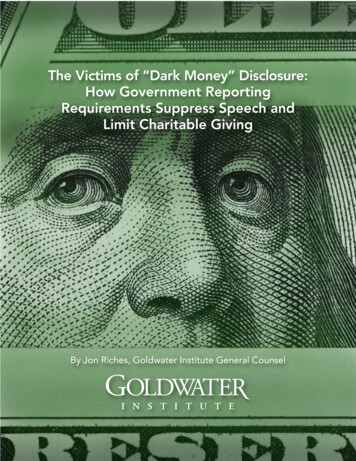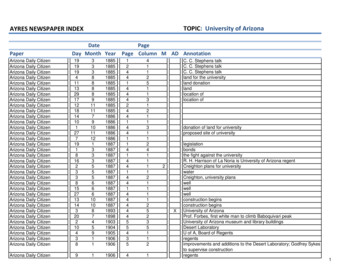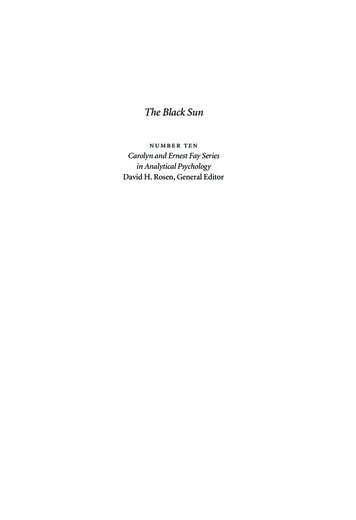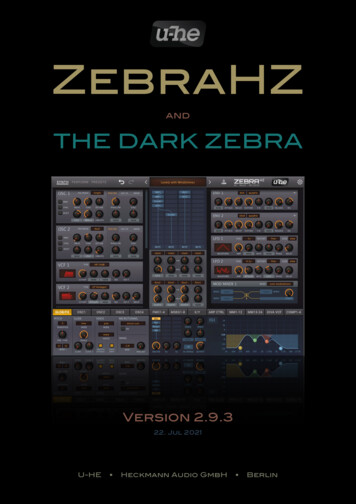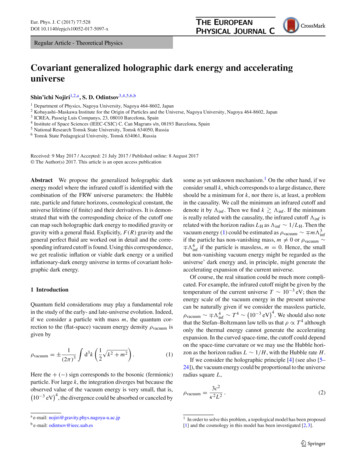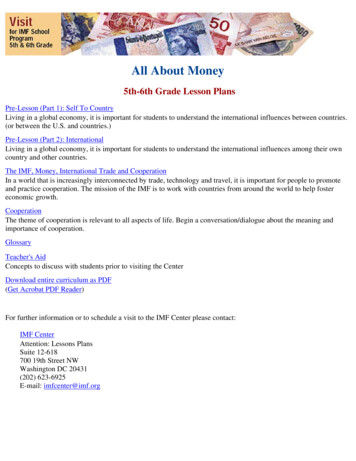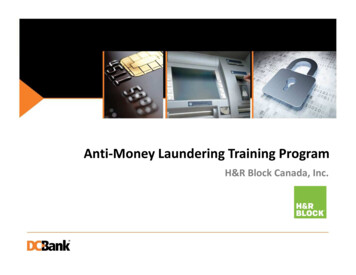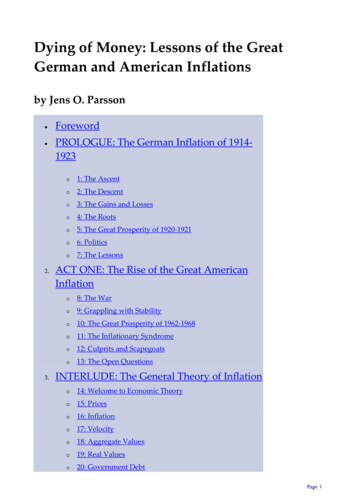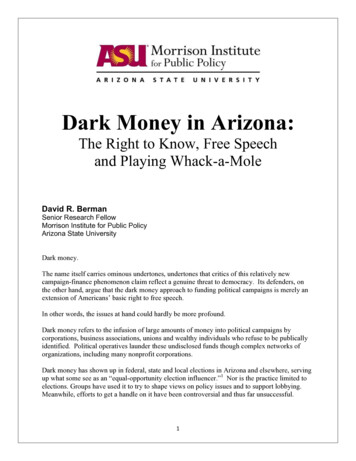
Transcription
Dark Money in Arizona:The Right to Know, Free Speechand Playing Whack-a-MoleDavid R. BermanSenior Research FellowMorrison Institute for Public PolicyArizona State UniversityDark money.The name itself carries ominous undertones, undertones that critics of this relatively newcampaign-finance phenomenon claim reflect a genuine threat to democracy. Its defenders, onthe other hand, argue that the dark money approach to funding political campaigns is merely anextension of Americans’ basic right to free speech.In other words, the issues at hand could hardly be more profound.Dark money refers to the infusion of large amounts of money into political campaigns bycorporations, business associations, unions and wealthy individuals who refuse to be publicallyidentified. Political operatives launder these undisclosed funds though complex networks oforganizations, including many nonprofit corporations.Dark money has shown up in federal, state and local elections in Arizona and elsewhere, servingup what some see as an “equal-opportunity election influencer.”1 Nor is the practice limited toelections. Groups have used it to try to shape views on policy issues and to support lobbying.Meanwhile, efforts to get a handle on it have been controversial and thus far unsuccessful.1
A Historic Supreme Court DecisionThe flow of dark money increased dramaticallyfollowing the U.S. Supreme Court’s 2010 decisionin Citizens United v. Federal Election Commission.This decision erased limits on how muchcorporations, unions and other organizations candirectly spend for or against candidates for officethrough campaign advertising. More broadly, thecourt ruled in favor of a system of unlimitedspending by outside groups acting independently ofthe candidates they manylegislativeraces.”– 3Encouraged by the decision, many corporations andwealthy individuals raised their contributions tooutside political campaigns. Some chose to workthrough Super PACs, a type of political-action committee that came into being as the result ofthe Citizens United ruling. Others chose to go through non-profit tax-exempt entities formedunder the U.S. Internal Revenue tax code.Social welfare organizations, organized under Section 501 (c) (4) of the tax code, have been ofparticular use to those who would hide the identity of donors. These non-profit entities mayengage in political activities without donor disclosure as long as their primary purpose remainssocial welfare. Tax experts have commonly taken this to mean that at least 51 percent of theiractivities must fall into the social-welfare category.Social welfare nonprofits frequently pass along funds to other organizations, funds that maywind up in the coffers of Super PACs or committeesworking for or against particular candidates or ballot“Ifirmlybelievethatanonymousmeasures. These organizations must report wherepoliticalspeechisnotadangertoourthey get their money. However, when the moneynation–ithasplayedanimportantcomes from a nonprofit, they must only disclose eechprotectsname of the nonprofit, leaving the original source ofthespeakerfromretribution,butitthe money tivenon- ‐profits,”ArizonaRepublic,Feb.23,2014In the 2011-2012 cycle, 1.3 billion of the 7 billionspent on federal elections came from groups operatingindependently of any candidate’s committee. Close tohalf of the outside spending came from Super PACs,while much of the rest – some 46 percent of the total –came from dark money groups, principally non-profitsocial-welfare groups. The growth in dark money usehas been impressive: Dark money nonprofits spent 336 million on presidential and congressionalcampaigns during the 2012 election cycle. In 2006,such groups reported less than 6 million on federalcampaign spending.22
Though dollar totals are lacking, many of the organizations spending on federal elections alsospend lavishly on state and even local elections. Large corporations and wealthy individualshave poured millions into politically active nonprofits through shell corporations formed instates where disclosure laws are minimal or non-existent. In these states, the only donor onrecord is the shell company.The complex systems built to launder funds through a variety of organizations to avoid donordisclosure resemble sets of Russian nesting dolls, where a series of hollow wooden figures fitinside larger ones. The process means that voters seeking the identities of campaign donorsencounter organization after organization listing other organizations as the source of the funds.Political operatives and fund-raisers have found that a “no-disclosure-of-donors promise” helpsgreatly in bringing in money for candidates or political causes. It also allows political operativesto portray their organizations as enjoying widespread “grassroots” support, when in fact theydepend on the support of one or two wealthy contributors.Initially, most of the dark money came from the conservative side. Gathering much mediaattention, for example, has been the chain of non-profits linked to billionaire industrialists Davidand Charles Koch. Liberal organizations, however, appear to be rapidly catching up.3 Darkmoney now flows into national, state, and local elections from the both the left and the right.Liberals worry about right-wing organizations, including Americans for Prosperity in the Kochnetwork. Conservatives, on the other hand, worry about union contributors, organizations like theLeague of Conservation Voters and progressive big-money donors such as billionaire GeorgeSoros.California Revelations: The Arizona ConnectionThe issue of dark money captured national headlines in 2013, when California’s politicalcampaign watchdog agency, the Fair Political Practices Commission (FPPC), exposed a networkthrough which nonprofit organizations funneled 11 million to influence voters on ballotpropositions in California’s 2012 election.The FPPC suspected something was amiss in October 2012 when Americans for ResponsibleLeadership (ARL), an obscure Arizona-based 501 (c)(4) nonprofit headed by former Arizona House“WithitsaggressiveelectionsSpeaker Kirk Adams and with no history of politicalcommissionassertingserious- ‐mindedactivity in California, contributed funds to twodisclosurerequirements,Californiapolitical action committees there. One committeeprovedthatstatesdonothavetosupported an anti-union initiative and the othermeeklyallowanonymousopposed a tax increase, both on the California ballot‘independentexpenditure’groupsin 2012.The money, ultimately spent on political advertising,came to ARL through a convoluted network of darkmoney nonprofit groups in Virginia and –Editorial,ArizonaRepublic,Oct.25,2013
associated with the Koch brothers. Another Arizona nonprofit in the Koch network, the Center toProtect Patient Rights, headed by Sean Noble, an aide to former Arizona Congressman JohnShadegg, was also involved in the distribution of funds into the California campaigns in what theFFPC said amounted to a money-laundering scheme.4The California venture did not turn out well for the Kochs. The dark money organizations lostboth proposition fights, and a court forced organizers to reveal the names of some of the donors.More important, the revelations prompted a nationwide inquiry into the dark money issue andbrought pressure in Washington, D.C. and state capitols to do something to require timelydisclosure of donors.Developments in ArizonaMillions of dark money dollars have been sloshing around Arizona, much of it from out-of-statedonors. In 2012, it showed up in congressional contests and state legislative races; in 2013, itsurfaced in Phoenix’s municipal elections. Ballot measures have also been involved. Forexample, Americans for Responsible Leadership was active in Arizona as well as California in2012, spending around 1.6 million to defeat propositions that would have created a “top-two”primary system and extended Arizona’s temporary 1-cent sales-tax increase.In 201l, Noble’s organization in the Koch network helped fund an organization known as FairTrust in Arizona. Lawyers for this group attempted to influence the Arizona IndependentRedistricting Commission’s creation of new maps for state legislative and congressional districts.At the time, the group refused to reveal its donors, despite repeated requests from somecommission members.5In 2013, Arizona Public Service Company admitted having given two nonprofits close to 4million to run ads concerning net-energy metering – an issue in dispute between APS and thesolar-power industry. The two nonprofits, 60 and Prosper, were also associated with Noble.That year, dark money was also behind television ads and mailers by the Arizona Public IntegrityAlliance that were critical of Attorney General Tom Horne for alleged campaign-financemisconduct. Secretary of State Ken Bennett dismissed a complaint against the group, finding thatthe Arizona Public Integrity Alliance was a nonprofit organization that does not have to reportwhere its money comes from. Moreover, Bennett“Peoplehavetherighttoplayintheconcluded, the group did not even have to report howpoliticalarena.Theydon’thavemuch it was spending on the ads because they fell intotherighttohidewhotheyare.”the category of issue advocacy, rather than–Sen.SteveFarley,D- alleyDailyNews,Feb.4,2013Until recently, little attention has been paid to thenonprofit dark-money groups that register with theArizona Corporation Commission. Many of them appearquickly, register with the Commission, and just asquickly disappear after Election Day because their workis over.6 As evidenced in the California revelations,4
some of these have been active not only locally but in other states.A Range of ResponsesIn the 2013 legislative session, state Democrats proposed forcing disclosure of dark moneydonors to nonprofits; their bills, however, found little traction in the Republican-controlledLegislature. By 2014, though, members of both parties expressed support for greater disclosure.State Sen. Michele Reagan, R-Scottsdale, chair of the Senate Elections Committee, sponsored ameasure (SB1403) that would require independent expenditure committees in state and localelections to reveal the “identifiable contributors” to their campaigns, even though these fundscame to them through a chain of organizations.The “identifiable contributor” noted in the bill is the specific person(s), corporation(s), orunion(s) from within or outside of Arizona that makes the initial donation, not some vaguelynamed entity that passed the funds along. The independent committee would also be required toreveal the name of the leading three financers in its campaign advertisements, literature andsimilar materials.A central focus of SB1403 is on Arizona’s many shell corporations or “conveniencecorporations” that seek to influence elections without revealing the identity of their funders. Thebill outlaws attempts to hide the identity of donors by the creation of such entities and byfunneling funds from one organization to another. To enforce the law, the Secretary of State,acting upon a complaint, would have wide authority to determine if a group or organization isprimarily engaged in electioneering. If so, it would be regulated as a political committee and besubject to disclosure.Critics of SB1403 argued that the bill gives too much power to election officials and wouldaccomplish little more than produce a chilling effect on free speech. By the middle of February2014, the bill had stalled in the Senate, failing to get out of committee. Reagan lashed out atlobbyists for the Arizona Chamber of Commerce, the Arizona Federation of Labor and othergroups opposing the bill.“They don’t want this discussion,” Reagan said. “They don’t want to change. They want statusquo. . . Their clients do not want us to see what they’re doing.”7National and State RemediesUltimately, the search for effective solutions to the dark money problem will depend heavilyon what happens in the nation’s capitol. Thus far, Congress has sputtered in its effort to bringgreater disclosure. A proposed DISCLOSE (Democracy Is Strengthened by Casting Light OnSpending in Elections) bill, which would require disclosure of the names of those giving morethan 10,000 (in its latest version) to independent expenditure groups, including non-profits,has yet to secure the necessary support.Those seeking reform have also called upon various federal agencies to take actions that wouldenhance disclosure. Critics have faulted the Federal Election Commission, U.S InternalRevenue Service, Federal Communications Commission, and Securities and Exchange5
Commission for creating or contributing to the dark money problem, and have asked them totake corrective steps.8 Late in 2013, the IRS began moving toward containing somewhat thepolitical activities of the nonprofits, but these efforts have encountered considerableopposition.Because of U. S. Supreme Court decisions, statescannot do anything to prevent corporations, businessassociations, unions or other groups or individualsfrom spending all they want on political campaigns.Nor can states alter federal tax or campaign laws. TheCalifornia episode demonstrates, however, that statesare not powerless in this arena. They can act toenforce disclosure rules on nonprofit and otherentities that are attempting to influence state and ateoffice,anon- ‐profit,public- altLakeTribune,Jan.22,2014Thus far, state legislators have been less concernedwith disclosure than with the fact that spending byindependent dark money groups has been rapidlyincreasing. Seeking to counter the influence ofindependent groups, many state lawmakers haveincreased the amount of money individuals can contribute to legislative and other campaigns.Sponsors of increasing limits have argued that candidates for state office need more money tocompete with outside dark money organizations. On this matter, there seems widespreadagreement among Republicans and Democrats. In 2013 alone, legislatures in eight statesincluding Arizona approved higher limits. Several more are poised to do so.9In some states, legislators have coupled higher contribution limits with donor disclosure.Watchdog groups contend, however, that allowing more disclosure should not come at the costof allowing more money to flow directly to candidates from wealthy donors. To them, bothdisclosure and strict campaign contribution limits are necessary.10The need for donor disclosure has caught the attention of state attorneys general, electionofficials and legislators throughout the country. Some have called for laws along the lines ofthe proposed DISCLOSE Act. In California, a bill of this nature is currently awaiting thegovernor’s signature. It strengthens an already strong set of laws by giving the FPPC moreauthority to require tax-exempt political nonprofits to reveal their donor lists.In 2012, Rhode Island passed a law requiring certain tax-exempt organizations to reveal thenames of the top five top donors to issue ads aired in state candidate or ballot elections, and topublically disclose the names of those contributing 1,000 or more to the organization. Utah,responding to a scandal involving dark money, passed a law that requires corporations,including nonprofits, to disclose their donors if their spending on election campaigns exceeds 750.6
Early in 2014, there was considerable interest expressed in a proposal in the Washington Statelegislature that would have required nonprofits that spend 100,000 or more in statewide races,or more than 20,000 in local races, to disclose donors of 2,000 or more. Legislative leaders,however, refused to bring the bill to the floor for a vote. It appeared that many legislators did notwant to go on record against disclosure, preferring instead to let the issue become lost in theprocess without a formal vote.11 Similar maneuvers appear to have been used in other states,including Arizona.Pros, Cons and ProspectsRequiring donor disclosure has long been a cornerstone of state governments’ efforts to regulatecampaign spending. Indeed, Arizona’s first governor, George W.P. Hunt, led the charge. Heargued that Arizonans suffered because of behind-the-scenes manipulations by wealthy businessleaders out to further their own interests. Hunt’s campaign against this “invisible government”led to reform proposals calling for more public disclosure of those behind campaign andlobbying activities.Modern-day proponents of disclosure argue that they are not seeking to prevent speech, butonly to let the public know who is speaking. A related argument is that people – corporationsincluded – should be willing to stand up for what they believe. Although their views may beunpopular, this argument continues, laws exist to prevent retaliation for what they say.12Opponents of mandatory disclosure, on the other hand, contend that disclosure requirementshave a chilling effect on the right of free speech guaranteed by the First Amendment of theU.S. Constitution. Disclosure requirements, they say, may make some citizens less willing tospeak out for fear of harassment for airing their views. This, they argue, discourages politicalparticipation and the full airing of views that should be heard in the public policy marketplace.Many corporate leaders value anonymity because of concerns about what their shareholders,employees and customers might think about their taking a stand on a candidate or issue.Backlashes such as boycotts are a possibility. Business leaders too may be wary of possibleretaliation from unions or public officials. Infact, leaders of the U.S. Chamber of Commerceand many large corporations have viewed the“Ithinkit’sreallyimportantthatweallowdemand for more disclosure as essentially anourcitizensandvoterstosee(who’s)payingeffort from the Left to diminish the influence offordifferentcampaigns.Ihaveto,asathe business community in the oarena.13me.Itseemslikeano- rom.”–Sen.MicheleReagan,R- zonaCapitolTimes,Nov.22,2013However, some companies see value indisclosure. A recent study by the Center forPublic Integrity, a nonprofit, nonpartisanwatchdog organization, found that about a thirdof the Fortune 300 companies voluntarilydisclose their contributions to politicallyengaged nonprofits. They see transparency as agood business practice for building thereputation and image of the corporation and for7
promoting public trust. 14Disclosure of dark money donors is a relatively new area for the states. It is also one marked byconsiderable uncertainty over what can and should be done, and by considerable politicalresistance. The laws that do exist are largely works in progress. The legislative road ahead islikely to be one of trial and error, as lawmakers move toward effective remedies that canwithstand political and legal challenges. Meanwhile, dark money is likely to play an increasinglyimportant role in elections, as is already apparent concerning the 2014 campaigns. 15Opponents of disclosure commonly cite the difficulty of passing truly effective legislationagainst it. They argue that trying to do so is like playing the popular “Whack-a-mole” game: Asone avenue of autonomous spending is forced down, another pops up. Faced with new obstacles,opponents say, wealthy donors may well find a way to game the system or circumvent the lawthough other means. In the end, for example, they might disclose more but also increase theirinfluence on policy by raising their direct contributions to candidates.What should Arizona do? Questions surrounding donor disclosure, free speech rights andcontribution limits remain much in dispute. But few on either side of the debate would deny thatthe issues involved are vital to a healthy political system.NOTES1E- e2011- press/press2013/20130419 2012- ‐24m- on- secrets.org/outsidespending/fes summ.php?cycle www.opensecrets.org/news/2013/11/liberal- ‐dark- ‐money- ‐dominating- ‐2014- f.FinesAriz.Non- istributing Pulica,“HowaformerArizonacongressionalaide cationsCommission;LiliLevi,“PlanBForCampaign- ‐FinancedReform:Canthe28
tonDarkMoneyStruggle,”TheSpokesman- onsfunneled ursday,Jan.16,201414Ibid15Maguire,“LiberalDark- noutreachtohelpimprovethestate’squalityoflife.9
came from dark money groups, principally non-profit social-welfare groups. The growth in dark money use has been impressive: Dark money nonprofits spent 336 million on presidential and congressional campaigns during the 2012 election cycle. In 2006, such groups reported less than 6 million on federal campaign spending.2

